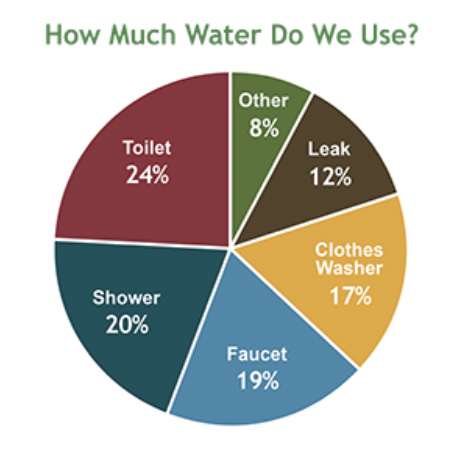Indoor Water Conservation
New ResidentialWhat is Indoor Water Conservation?
Indoor water conservation refers to home operations, occupant behaviors and water-efficient fixtures and appliances that help to reduce overall water consumption in a home. In New Jersey, the average New Jersey resident uses 70 gallons of water per day, with outdoor irrigation making up the most significant percentage of total water use (see Water Efficient Landscaping).[1] Figure 1 shows that the most significant areas for potential indoor water savings in typical residential buildings are restrooms including toilets, showerheads, and faucets, clothes washers, and leaks.[2]
New Jersey’s receives ample average rainfall of 45 inches per year, and the state’s geology supports the storage of large quantities of groundwater and surface water reservoirs. Preventative conservation efforts and water-efficient equipment upgrades can reduce the risk of water shortages and reduce costs associated with increasing population growth, aging water infrastructure, and climate change impacts such as droughts.[3]
Indoor water conservation generally addresses water use reductions in four areas:[4]
- Reducing water losses associated with leaks.
- Increasing the water efficiency of fixtures, equipment, systems, and processes.
- Educating homeowners and tenants about water conservation to encourage water-saving behaviors.
- Reusing onsite wastewater for irrigation and non-potable uses.

Figure 1 – End Uses of Water in Residential Buildings (Source: Water Resource Foundation, 2016)
How to Implement Indoor Water Conservation
Implementing indoor water conservation in a residential building typically includes:[5]
- Installing water meters and sub-meters and leak detection sensors to track water usage, find and fix leaks and equipment failures, and identify opportunities for water savings (see Smart Meters, and Smart Sensors and Controls).
- Specifying low-flow, WaterSense certified fixtures such as toilets, showers, faucets, and aerators, and energy-efficient, EnergyStar certified appliances, such as dishwashers and clothes washers, that also conserve water (see Energy Star Equipment and Plug Load).
- Properly maintaining HVAC systems to minimize water used for heating and cooling equipment.[6]
- Minimizing irrigation or recovering wastewater for irrigation and uses that do not require potable water such as toilet and urinal flushing (see Water Efficient Landscaping, Rain Barrels and Cisterns, On-Site Alternative Water Reuse).
- Educating homeowners and tenants on water conservation efforts and procedures to ensure the proper use of water-saving equipment (e.g., homeowner and manufacturer manuals).
Example
US EPA WaterSense Labeled Homes
WaterSense Labeled Homes Version 2 establishes a mandatory checklist and performance criteria to earn the WaterSense label. The mandatory checklist for WaterSense Labeled Homes includes a pressure-loss test of all water supplies and a visual leak inspection for toilets, bathroom, and kitchen faucets, shower heads, and fixtures and appliances. The checklist also requires WaterSense labeled toilets, bathroom sink faucets, and showerheads. Also, a WaterSense labeled home must be 30 percent more water efficient than typical new construction (based on national standards and requirements).[7]
Benefits
Indoor water conservation reduces the strain on natural water resources and ensures future water supplies.[8] Water saving fixtures and appliances save money on water and energy bills without sacrificing performance, the latter savings due to the significant amount of energy often used to heat water.[9] For example, toilets account for nearly 30% of water use in the average home. Households that install WaterSense labeled toilets, which use 1.28 gallons per flush use 20% less water than households that install standard toilets, which use 1.6 gallons per flush.[10] EnergyStar certified dishwashers use 30% less water and are 12% more energy efficient than standard models.[11] Indoor water conservation can also reduce the costs and the amount of energy required to treat, pump, and transport water and wastewater.[12]
Costs
The rising cost over the last decade of water and wastewater services can make minor investments in water conservation strategies and technologies cost-effective based on the savings alone from reduced water bills.[13] Factoring in savings from reduced energy bills further reduces payback periods.
Resiliency
Indoor water conservation enhances resiliency by reducing impacts from droughts and other instances of water scarcity. Water use reductions also decrease the reliance and stress on the entire municipal water infrastructure including groundwater pumping, and water and wastewater treatment and distribution, reducing the likelihood of system overload and failure.[14]
[1] US EPA WaterSense. 2010. New Jersey Water Fact Sheet. https://www.epa.gov/sites/production/files/2017-02/documents/ws-ourwater-new-jersey-state-fact-sheet.pdf (accessed Oct 29, 2018).
[2] US EPA WaterSense. 2012. Saving Water in Office Buildings. https://www.epa.gov/sites/production/files/2017-01/documents/ws-commercial-factsheet-offices.pdf (accessed Oct 25, 2018).
[3] New Jersey Department of Environmental Protection, 2017, New Jersey Water Supply Plan 2017-2022: 484p, https://www.state.nj.us/dep/watersupply/pdf/wsp.pdf (accessed Oct 25, 2018).
[4] US EPA WaterSense. 2012. WaterSense at Work: Best Management Practices for Commercial and Institutional Facilities. https://www.epa.gov/sites/production/files/2017-02/documents/watersense-at-work_final_508c3.pdf (accessed Oct 26, 2018).
[5] US EPA WaterSense. 2018. Types of Facilities. https://www.epa.gov/watersense/types-facilities (accessed Oct 25, 2018).
[6] US EPA. 2017. Water Management and Best Practices at EPA. https://www.epa.gov/greeningepa/water-management-plans-and-best-practices-epa (accessed Oct 25, 2018).
[7] US EPA WaterSense. 2018. WaterSense Specification for Home Version 2 Concept Paper https://www.epa.gov/sites/production/files/2018-10/documents/ws-homes-v2-concept-paper.pdf (accessed Oct 31, 2018).
[8] NJ DEP Division of Water Supply and Geoscience. 2018. The Case for Water Conservation in New Jersey. https://www.state.nj.us/dep/watersupply/conserve.htm (accessed Oct 26, 2018).
[9] US EPA WaterSense. 2012. Best Management Practices for Commercial and Institutional Facilities. https://www.epa.gov/sites/production/files/2017-01/documents/ws-commercial-factsheet-general-ci.pdf (accessed Oct 26, 2018).
[10] US EPA WaterSense. 2018. Residential Toilets. https://www.epa.gov/watersense/residential-toilets (accessed Oct 31, 2018).
[11] US Energy Star. 2018. Dishwashers. https://www.energystar.gov/products/appliances/dishwashers (accessed Oct 31, 2018).
[12] NJ DEP Division of Water Supply and Geoscience. 2018. The Case for Water Conservation in New Jersey. https://www.state.nj.us/dep/watersupply/conserve.htm (accessed Oct 26, 2018).
[13] Joseph Bourg. 2016. Water Conservation. Whole Building Design Guide – A Program of the National Institute of Building Science. https://www.wbdg.org/resources/water-conservation (accessed Oct 26, 2018).
[14] Ibid.
